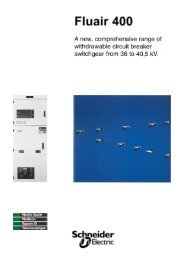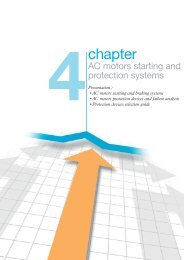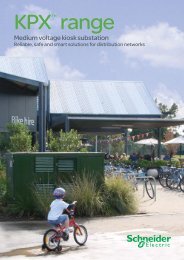Connect - Schneider Electric
Connect - Schneider Electric
Connect - Schneider Electric
Create successful ePaper yourself
Turn your PDF publications into a flip-book with our unique Google optimized e-Paper software.
2 SUSTAINABLE DEVELOPMENT<br />
SCHNEIDER ELECTRIC’S COMMITMENT TO ENVIRONMENTAL PERFORMANCE<br />
64<br />
The objective for 2011 was to roll out EEM in 100 factories covering<br />
at least 75% of the Group’s total energy consumption. At the end<br />
of 2011, the target had been exceeded as 160 sites had energy<br />
consumption remote control tools, representing around 90% of<br />
total consumptions.<br />
The Green IT program<br />
Green IT is a program to reduce the energy consumption of<br />
<strong>Schneider</strong> <strong>Electric</strong>’s IT infrastructure (data centres, servers, and IT<br />
devices). It also aims to use IT technologies to reduce business<br />
travel using telepresence/HD videoconferencing systems.<br />
The main objectives are:<br />
• optimise the number of data centres and their energy effi ciency<br />
using <strong>Schneider</strong> <strong>Electric</strong> products and solutions;<br />
• train all IT employees on best effi ciency and carbon practices;<br />
• ensure that more than 80% of the equipment bought is Energy<br />
Star qualifi ed.<br />
The following measures were implemented in 2011:<br />
• consolidation of three of the main data centres operating the<br />
Group’s SAP platform on a single site with optimised energy<br />
effi ciency (PUE < 1.2), thus saving 240 MWh;<br />
• roll out of a Green IT electronic training module to all IT personnel;<br />
• continuation of a global server virtualization plan, resulting in an<br />
average cut of 40% in electrical consumption.<br />
Actions to reduce emissions linked to freight<br />
Long distance freight<br />
In 2011, the mobilisation of major players in the supply chain and<br />
logistics allow efforts to reduce air freight to be continued in favour<br />
of sea transport for long distance freight. The CO savings made<br />
2<br />
by these actions are included in the carbon indicator of the Planet<br />
& Society Barometer 2009-2011. In 2011, air freight tonnage<br />
represented 17% of joint air and sea tonnage, as against 20% in<br />
2010.<br />
Working on the structure of international fl ows – by making use<br />
of the growing importance of European and Singaporean hubs<br />
– has meant that the number of network point-to-point fl ows has<br />
been halved. This has resulted in a mass use of fl ows on maritime<br />
routes that link Europe to Asia and a reduction in greenhouse<br />
gas emissions.<br />
3.3 Eco-Design<br />
Approach<br />
If there is no general legal obligation on eco-design, the pressure<br />
on the use of natural resources, climate change and respect for<br />
biodiversity must encourage the public and private actors to<br />
mobilise around these questions.<br />
REGISTRATION DOCUMENT 2011 SCHNEIDER ELECTRIC<br />
Short distance freight<br />
Continual streamlining of the supply chain has allowed important<br />
fl ows in Europe from France to Russia to be transferred from a road<br />
route to a short sea route that is more reliable in terms of delays,<br />
less expensive and more environmentally friendly.<br />
<strong>Schneider</strong> <strong>Electric</strong> has taken an active role in the Smartway Europe<br />
initiative concerning road transport, which produces the most<br />
signifi cant portion of the Group’s emissions. Around thirty supply<br />
chain and some shipping multinationals are involved in this initiative<br />
that aims to promote a European framework to address the issue of<br />
CO transport emissions. <strong>Schneider</strong> <strong>Electric</strong> is particularly involved<br />
2<br />
in the thought process surrounding the development of a tool for<br />
reporting carbon dioxide emissions on a simple shared basis.<br />
The Company is also a stakeholder in the extension of Smartway<br />
Europe launched in Asia under the name “Green Freight Asia”.<br />
Smartway Europe and Green Freight Asia also allow for promoting<br />
good practise in terms of sustainable development in transport and<br />
for advocating the implementation of supranational rules regarding<br />
standardisation of emission measurement methods.<br />
Emission reduction target<br />
A new carbon audit was launched in 2011 at Group level that aimed<br />
to recover – on 70% of our transport costs at a global level – the<br />
greenhouse gas emissions generated by transport. This summary<br />
is based on the information provided by approximately 60 of the<br />
largest transport providers of the Group. The exercise has resulted in<br />
specifi c collaborative meetings with the transporters to understand<br />
better their calculation hypotheses and to start to plan the actions<br />
required to reduce their carbon footprint.<br />
More generally, a working framework was defi ned to detail the<br />
attributes of Preferred Suppliers with whom <strong>Schneider</strong> <strong>Electric</strong><br />
wants to develop the volume of activity. In order to become a<br />
Preferred Supplier, the transporter must be able to measure and<br />
provide information their carbon footprint.<br />
In 2011, training dedicated to greenhouse gas emissions in<br />
transport was implemented in order to emphasise the importance<br />
of this subject in the Group’s strategy, to explain to the teams how<br />
to measure and consolidate the quarterly CO emissions level to<br />
2<br />
the network at a global level and fi nally, how to indicate the ways of<br />
reducing CO emissions that are available to the supply chain teams.<br />
2<br />
A result of this work, 2011 ended with the decision to include a<br />
freight-linked CO emissions reduction target of 10% within the new<br />
2<br />
Company Program for the period 2012-2014.<br />
It is unusual for customers to explicitly specify environmental<br />
criteria for a product but having a “green supplier” is becoming a<br />
prerequisite.<br />
Global customers, particularly in the green construction or transport<br />
sectors or the authorities, need support to implement their<br />
environmental policies, especially to:<br />
• calculate and reduce their carbon footprint;

















